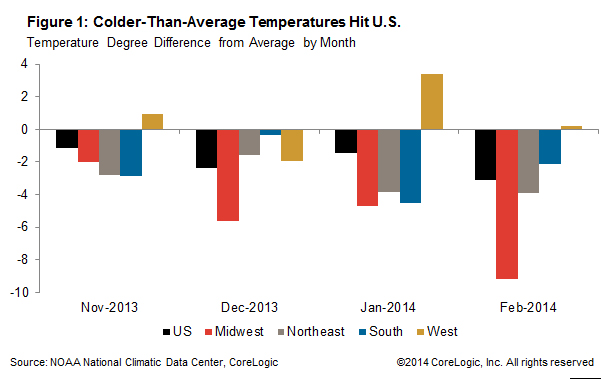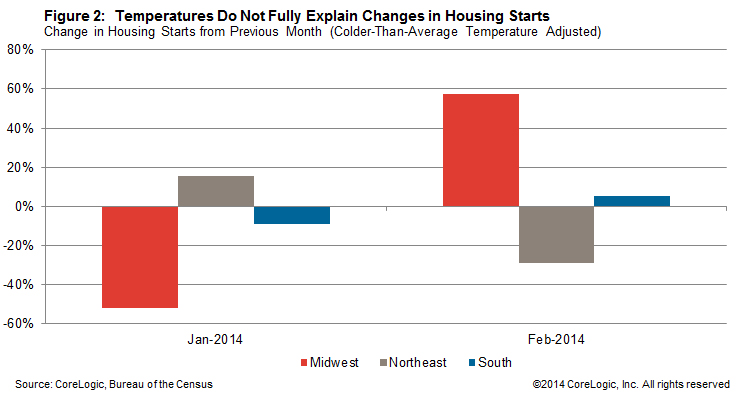In a recent blog post written by Molly Boesel CoreLogic questions the true role of the recent severe weather in a lag in single family housing starts. Those single family starts, a closely watched indicator of housing market health, were down by 13 percent from December to January and did not move appreciably in February.
Boesel said that the decline has been blamed on weather conditions as opposed to weakness in the housing sector but asks whether, assuming that is true, we can blame the Polar Vortex and seemingly endless snow for all reduced building activity.
The author looked at temperature history from January 1984 to February 2014 and compared it to data for that period on housing starts. To specifically address whether or not abnormally cold weather influenced building activity she also compared the temperature in a given calendar month to the average temperature for the month over the entire 30 year time span. She found that, for example, the average February temperature for 30 years of Februarys was 35.3 degrees while this past February it was 32.2 degrees, 3.1 degrees colder than normal. When those numbers are broken down by region however, it is clear that some parts of the country had much more severe temperatures than others. The Midwest was hit particularly hard with temperatures almost 10 degrees colder than average and the Northeast and South also had more extreme weather.

Boesel then looked at housing starts data and found it showed very different levels of activity by region. The 13-point January drop was not evenly distributed; the Midwest was down 55 percent, the South by 11 percent and the Northeast and West increased 8 and 11 percent respectively. The West was enjoying not only a large increase in housing starts but above average temperatures. So, she asks, since the West was doing so well, can we conclude that the below average temperatures were the cause of the construction slowdown in other regions?
Boesel says the seasonal adjustments used by the Census Bureau in constructing its housing starts data should account for the influence of cold weather by region so she ran a simple time series model to test whether the wealth/starts relationship on a regional basis. Her model shows that below average temperatures in winter months decrease starts and higher than average temperatures increase activity; a temperature difference of one percent led to a 24-percent change in housing starts in the Midwest, a 31-percent change in the Northeast and a 21-percent change in the South. Results for the West were not conclusive.
"Based on the model data, given the actual colder-than-average temperatures, the Midwest should have had a 6-percent decrease in housing starts in January and an 11-percent decrease in February. The Northeast should have had a 6-percent decrease in starts in January and a 5-percent decrease in February, and the South should have had a 2-percent decrease in January and a 1-percent decrease in starts in February," she said.
Figure 2 shows the weather adjusted change in housing starts for January and February 2014 using the model results discussed above - or the change in starts not explained by the weather. The article concludes that the weather is clearly a factor but does not account entirely for the monthly change in starts. "The 55-percent January decrease in housing starts in the Midwest cannot be completely attributed to the weather, but it is possible that the increase in February would have been bigger had the weather not been so cold. In the Northeast and South, the results are similar - colder-than-average temperatures don't sufficiently explain the significant decline in housing starts."

Boesel says her analysis suggests that, while past severe winters that hampered construction were followed by a rebound in activity once temperatures recovered, any rebound this spring "will not be sufficient enough to counteract the current weakness in the market that can't be blamed on the weather."







